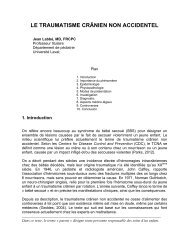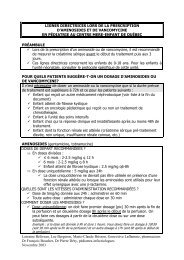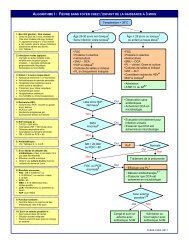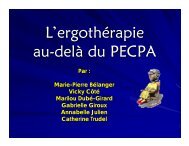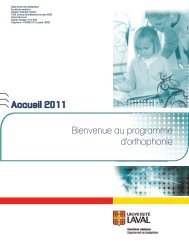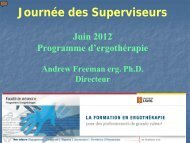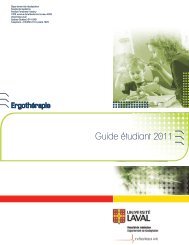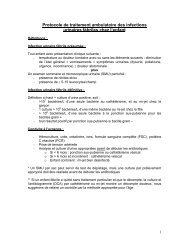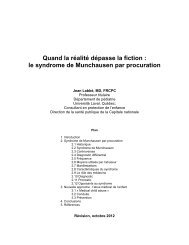Je suis Borderline! - Faculté de médecine - Université Laval
Je suis Borderline! - Faculté de médecine - Université Laval
Je suis Borderline! - Faculté de médecine - Université Laval
You also want an ePaper? Increase the reach of your titles
YUMPU automatically turns print PDFs into web optimized ePapers that Google loves.
Quel est l’impact ldu trouble <strong>de</strong>personnalité limite d’une dmère msur la relation avec son enfant etsur son rôle parental ?
Rôle parental : selon la loi <strong>de</strong> la protection<strong>de</strong> la jeunesse Trouble <strong>de</strong> personnalité limite : selon leDSM-IV et impacts fonctionnels expliquésavec le MOH (Labrosse & Leclerc, 2007) (Associationquébécoise <strong>de</strong> l’organisation limite <strong>de</strong> la personnalité,2008)
Modèle <strong>de</strong> l’occupation humaine : DESCRIPTION DU TPLSystème humainOccupationVolition :Déterminants personnels : Faible sentiment <strong>de</strong> compétence, image <strong>de</strong> soinégative, se valorise au profit d’autruiValeurs : Difficulté à définir ses valeurs, parfois infidèles à ses valeurs.Intérêts : Recherche à fuir la douleur émotionnelle, intérêts instables, peudéfinis et souvent inadéquats, intérêts dictés par les relations du moment,difficulté à éprouver du plaisirHabituationHabitu<strong>de</strong>s : Instables, varient selon l’impulsivité du moment, routine <strong>de</strong> viedéséquilibrée, comportements criminels Difficultés à assumer ses rôles :conjointe, mère (difficulté à mettre un cadre), travailleuse (difficulté à gérerl’autorité, à maintenir un rythme <strong>de</strong> travail constant)Rôles : Difficultés à assumer ses rôles : conjointe, mère (difficulté à mettreun cadre), travailleuse (difficulté à gérer l’autorité, à maintenir un rythme <strong>de</strong>travail constant)Capacité <strong>de</strong> ren<strong>de</strong>mentExpérience subjective : Faible jugement, pris dans un corps objet
Modèle <strong>de</strong> l’occupation humaine : DESCRIPTION DU TPLSystème humainOccupationCompétence occupationnelleBaisse <strong>de</strong> la compétenceoccupationnelle et difficulté àmaintenir une vie satisfaisanteI<strong>de</strong>ntité occupationnelleSentiment <strong>de</strong> vi<strong>de</strong>, trouble <strong>de</strong>l’image <strong>de</strong> soi, difficulté àtrouver un sens à sa vieAdaptationoccupationnelleMécanismesadaptatifs nonadéquats (suici<strong>de</strong>,automutilation, abus<strong>de</strong> substances…),idéalisation oudévalorisationexcessive selon lessituations
les TPL adoptent <strong>de</strong>s positions extrêmesd’idéalisation ou <strong>de</strong> dévalorisation (Lamont,2006) résulte en <strong>de</strong>s comportements détachés,insensibles et clivés
difficulté à gérer leurs émotions donc moinsdisponibles émotionnellement avec leursenfants elles adoptent <strong>de</strong>s comportements impulsifs etauto-<strong>de</strong>structeurs (M me Marie-Line Na<strong>de</strong>au) elles présentent <strong>de</strong>s comportements intrusifset insensibles dans le jeu (Cran<strong>de</strong>ll, Mattew, &Hobson, 2003)
Pour ce qui est <strong>de</strong>s enfants... ils présentent <strong>de</strong>s regards fuyantset un affect dépressif(Newman, Stevenson, Bergman & al., 2007) ils sont moins disponibles à s’engagerpositivement dans la relation ils ont <strong>de</strong>s comportements désorganisés etdésorientés
le rôle parental est un défi stressant les mères se trouvent peu compétenteset éprouvent <strong>de</strong> l’insatisfaction difficulté à gérer le regard critique <strong>de</strong> lasociété (Carrière & al., 2007) le rôle parental peut être une motivationdans la thérapie (entrevue avec la mère à la cliniqueLe Faubourg St-<strong>Je</strong>an)
difficulté à assurer la protection, l’anticipation etla sécurité <strong>de</strong> leur enfant (Newman & Stevenson, 2005) difficulté à répondre correctement aux besoins <strong>de</strong>leurs enfants (entrevue avec la mère à la clinique LeFaubourg St-<strong>Je</strong>an) difficulté à être <strong>de</strong> bons partenaires <strong>de</strong> jeu (Cran<strong>de</strong>ll,Mattew & Hobson, 2003)
attachement désorganisé (Melnick, Patrick, Lyons-Ruth &al., 2003) impact négatif sur l’image <strong>de</strong> soi (Lamont, 2006) prévalence plus élevée pour le développement <strong>de</strong>troubles psychopathologiques (Barnow, Spitzer, Grabe &al., 2006) problèmes <strong>de</strong> contrôle <strong>de</strong> l’impulsivité et <strong>de</strong>comportements, retards <strong>de</strong> développement sentiment <strong>de</strong> culpabilité suite aux tentatives <strong>de</strong>suici<strong>de</strong>s et aux suici<strong>de</strong>s <strong>de</strong>s mères (Labrosse & Leclerc,2007)
DROITS DES PARENTS ET LA GARDE DEL’ENFANT SELON L’ASPECT LLÉGALL loi sur la protection <strong>de</strong> la jeunesse droits <strong>de</strong> l'État direction <strong>de</strong> la protection <strong>de</strong> lajeunesse gar<strong>de</strong> <strong>de</strong> l’enfant
2.3 APPROCHES ET THÉORIE UTILISÉES thérapie dialectique comportementale approche <strong>de</strong>s schémas approche systémique théorie <strong>de</strong> l’attachement
2.4 OUTILS D’ÉD’ÉVALUATION UTILISÉS• DSM-IV• SCID- II• DIB-R• évaluation <strong>de</strong>s habiletés parentales• évaluations en ergothérapie : OPHI-II,OSA, ACIS
2.5 INTERVENTIONS GÉNÉRALESG comprendre les interactions ainsi que laperception parentale : Getting to know you(Newman, Stevenson, Bergman & al., 2007) Watch wait and won<strong>de</strong>r (Newman & Stevenson,2008)
2.5 INTERVENTIONS GÉNÉRALES G(SUITE) normalisation du vécu: programme <strong>de</strong> pairsaidants(Labrosse & Leclerc, 2007) interventions familiales (Allen & Farmer, 1996) programme <strong>de</strong> périnatalité, Institutuniversitaire <strong>de</strong> santé mentale, C.H. Robert-Giffard
ATTITUDES FACILITANTESmise en action/responsabilisationétablir le cadre thérapeutique et gar<strong>de</strong>rune distance thérapeutique afin d’éviterle clivage(Laporte, 2007)
3.1 CRITIQUE DES ÉCRITS critique <strong>de</strong>s concepts principales forces <strong>de</strong>s articles : objectifs précis,résultats, métho<strong>de</strong>s <strong>de</strong> recherche… principales limites <strong>de</strong>s articles : petitséchantillons, variables <strong>de</strong> confusion, recherchestransversales, peu d’évaluations fonctionnelles… recommandations pour <strong>de</strong>s étu<strong>de</strong>s futures
3.2 RÔLES DE L’ERGOTHLERGOTHÉRAPEUTERAPEUTECADRE DE L’ERGOTHÉRAPIE SELON LES 3 AXESnouveauxapprentissagesen ergothérapieÊtre occupationnelmeilleureconnaissancedu TPLenvironnementdu clientINTERVENTIONContextes spatio-temporels
3.2 RÔLES DE L’ERGOTHLERGOTHÉRAPEUTE RAPEUTE (SUITE)OBJECTIFS‣ reprise <strong>de</strong>s rôles (Bassett & Lloyd, 2005)‣ réorganiser une routine familiale‣ développer les habiletés fonctionnelles etintra-personnelles‣ stimuler la résolution <strong>de</strong> problèmes (Carrière,Clément, Tétreault & al., 2007)‣ développer le sens <strong>de</strong> l’autocritique‣ gestion <strong>de</strong>s émotions
3.2 RÔLES DE L’ERGOTHLERGOTHÉRAPEUTE RAPEUTE (SUITE)Programmes d’interventions‣ Au Québec: interventions axées davantagesur les symptômes‣ programme Living with Un<strong>de</strong>r-Fives enAustralie (Bassett, Lampe & Lloyd, 2001)
3.3 RESSOURCES DISPONIBLES À QUÉBEC Ressources du réseau <strong>de</strong> la santé et <strong>de</strong>sservices sociaux Institut universitaire <strong>de</strong> santé mentale, C.H.Robert-Giffard Services communautairesLa BoussoleParents-espoirs
3.4 PROBLÈMES ET PISTES DE SOLUTIONS problème: plusieurs intervenants solution: approche centrée sur la familleavec un intervenant pivot qui assure laliaison
3.4 PROBLÈMES ET PISTES DE SOLUTIONS (SUITE) problème: manque d’informations et <strong>de</strong>formations concernant le rôle parental solution : approfondir les recherches etformer les futurs étudiants energothérapie
3.4 PROBLÈMES ET PISTES DE SOLUTIONS (SUITE)problème: certaines mères ne <strong>de</strong>man<strong>de</strong>nt pasd’ai<strong>de</strong> car elles craignent <strong>de</strong> perdre la gar<strong>de</strong><strong>de</strong> leur enfantsolution: sensibiliser la société et lesintervenants à la situation <strong>de</strong>s mères atteintesd’un TPL
3.5 PISTES DE RECHERCHES étudier davantage le rôle parental lié auTPL approfondir les impacts à long terme surles enfants
3.5 PISTES DE RECHERCHES (SUITE) développer <strong>de</strong>s outils d’évaluation du rôleparental créer <strong>de</strong>s programmes d’entraînementaux habiletés parentales au Québec pourles TPL
CONCLUSION le rôle parental est affecté par le TPL interventions pertinentes pertinence <strong>de</strong> l’ergothérapie dans cedomaine
REMERCIEMENTS M me Brigitte Lefebvre M me Renée Bourbonnais M me Monique Carrière M me Marie-Lyne Na<strong>de</strong>au, erg. à l’Institutuniversitaire <strong>de</strong> santé mentale, clinique Le Faubourg Saint-<strong>Je</strong>an M me X, mère ayant un TPL suivie à la clinique LeFaubourg St-<strong>Je</strong>an M me Lise Laporte, chercheure à l’Institut <strong>de</strong> recherchepour le développement social <strong>de</strong>s jeunes M me Hélène Gagnon, responsable au centre <strong>de</strong>ressources du Centre <strong>Je</strong>unesse <strong>de</strong> Québec
RÉFÉRENCESRENCESBouvard, M. (2002). Questionnaires et échelle d’évaluation <strong>de</strong> la personnalité (2 e éd.). Paris, France: Elsevier-Masson.Carrière, M., Clément, M., Tétreault, S., Pépin, G. (2007). Analyse du champ <strong>de</strong>s services aux familles dont unparent a un trouble <strong>de</strong> santé mentale grave : éléments pour l’intégration <strong>de</strong>s services (Rapport <strong>de</strong> recherche).Québec, Qc. : Département <strong>de</strong> réadaptation, Faculté <strong>de</strong> mé<strong>de</strong>cine, Université <strong>Laval</strong>.Carrière, M., Clément, M., Tétreault, S., Pépin, G., Fortier, M., Paquet, S. (2007). Attentes <strong>de</strong>s familles dont la mèresouffre d’un trouble <strong>de</strong> santé mentale et services possibles en ergothérapie. Présentation Power Point auRegroupement <strong>de</strong>s ergothérapeutes œuvrant en santé mentale dans les régions 03 et 12.Labrosse, R & Leclerc, C. (2007). Trouble <strong>de</strong> personnalité limite et réadaptation. St-Jérôme, Qc : ÉditionsRessources.Linehan, M.M. (2000). Traitement cognitivo-comportemental du trouble <strong>de</strong> personnalité état-limite. Chêne-Bourg,Genève: Éditions Mé<strong>de</strong>cine & Hygiène.Linehan, M.M. (2000). Manuel d’entrainement aux compétences pour traiter le trouble <strong>de</strong> personnalité état-limite.Chêne-Bourg, Genève: Éditions Mé<strong>de</strong>cine & Hygiène.Parent, I. (2003). Exploration <strong>de</strong>s concepts d’intentionnalité et <strong>de</strong> projet <strong>de</strong> vie en vue <strong>de</strong> leur utilisation dans letraitement et la réadaptation <strong>de</strong>s personnes présentant un trouble <strong>de</strong> personnalité limite. Québec, Qc. :Département <strong>de</strong> réadaptation, Faculté <strong>de</strong> mé<strong>de</strong>cine, Université <strong>Laval</strong>.Rainville, S. (Coll.). (2001). L’abandon l’enfant : dépister, accepter, accompagner. Montréal, Qc : Sciences et culture.Rusinek, S. (2006). Soigner les schémas <strong>de</strong> pensée. Paris, France: Dunod.Saint-Jacques, M-C & coll. (2000). Les pratiques d’implication parentale dans l’intervention en protection <strong>de</strong> lajeunesse. Centre jeunesse <strong>de</strong> Québec. Page 13-20-41Vincent, I., (2007). Notes du cours Psychopathologie et psychosomatique, Notes <strong>de</strong> cours non publiées, Université<strong>Laval</strong>, Département <strong>de</strong> réadaptation.Pagé, D. (2006). <strong>Bor<strong>de</strong>rline</strong> : retrouver son équilibre. Paris, FR : Odile Jacob.
RÉFÉRENCESRENCESAbela, J.R., Skitch, S.A., Auerbach, R.P., & al. (2005). The impact of parental bor<strong>de</strong>rline personality disor<strong>de</strong>r on vulnerability to<strong>de</strong>pression in children of affectively ill parents. Journal of Personality Disor<strong>de</strong>rs, 19 (1), 68-83.Allen, D.M. & Farmer, R.G. (1996). Family relationships of adults with <strong>Bor<strong>de</strong>rline</strong> Personality Disor<strong>de</strong>r. Comprehensive Psychiatry, 37,43-51.Barnow, S., Spitzer, C., Grabe, H.J., Kessler, C. & Freyberger, H. J. (2006). Individual Characteristics, Familial Experience, andPsychopathology in Children of Mothers With <strong>Bor<strong>de</strong>rline</strong> Personality Disor<strong>de</strong>r. American Aca<strong>de</strong>my of Child and AdolescentPsychiatry, 45, 965-972.Bassett, H., Lampe, J., & Lloyd, C. (2001). Living with Un<strong>de</strong>r-Fives: a Programme for Parents with a Mental illness. British Journal ofOccupationnal Therapy, 64, 23-28.Bassett, H., & Lloyd, C. (2005). At-risk families with mental illness: Partnerships in pratice. New Zealand Journal of OccupationnalTherapy, 52, 31-57.Blanchette, L. & coll. (Novembre 1999). L'approche systémique en santé mentale. Les Presses <strong>de</strong> l'Université <strong>de</strong> Montréal, 213.Bouchard, S. (2003). Approche cognitive du trouble <strong>de</strong> personnalité limite : intérêt et limites actuelles. Revue Québécoise <strong>de</strong>Psychologique, 2, 211-226Cran<strong>de</strong>ll, L.E., Patrick M., & Hobson R.P. (2003) ‘Still-face’ interactions between mothers with bor<strong>de</strong>line personality disor<strong>de</strong>r and their2-months-old infants. British Journal of Psychiatrie, 183 p.239-247.Joyce, P.R., McKenzie, J.M., Luty, S.E., & al., (2003). Temperament, childhood environement and psychopathology as risk factors foravoidant and bor<strong>de</strong>rline personality disor<strong>de</strong>rs. Australian and New Zealand Journal of Psychiatry, 37, 756-764.Kahng, S.K., Oyserman, D., Bybee, D. & Mowbray, C., (2008). Mothers With Serious Mental Illness: When Symptoms Decline DoesParenting Improve? Journal of Family Psychology, 22, 162-166.Lamont A.E., Mothers with Personnality Disor<strong>de</strong>r (2006). Graduate Stu<strong>de</strong>nt Journal of Psychology, Columbia University Vol 8., p.39-44Laporte, L. (2007). Un défi <strong>de</strong> taille pour les centres jeunesse. Intervenir auprès <strong>de</strong>s parents ayant un trouble <strong>de</strong> personnalité limite.Santé Mentale au Québec, 32, 97-114.Lobbestael, J., Arntz, A. & Sieswerda, S., (2005). Schema mo<strong>de</strong>s and childhood abuse in bor<strong>de</strong>rline and antisocial personalitydisor<strong>de</strong>rs. Journal of Behavior therapy and Experimental Psychiatry 36, 240-253.Newman, L.K & Stevenson, C.S., (2005). Parenting and Bor<strong>de</strong>line Personnality Disor<strong>de</strong>r: Ghosts in the Nursery. Clinical ChildPsychology and Psychiatry vol 10(3), p.385-394.Newman, L.K., Stevenson, C.S., Bergman L.R. & Boyce P., (2007). <strong>Bor<strong>de</strong>rline</strong> personality disor<strong>de</strong>r, mother-infant interaction andparenting perceptions: preliminary findings. Australian and New Zealand Journal of Psychiatry. 41, 598-605.Nordahl, H.M. & Nysaeter, T.E. (2005). Schema therapy for patients with bor<strong>de</strong>rline personality disor<strong>de</strong>r : a single case series. Journalof Behavior Therapy, 36, 254-264.Pizur-Barnekow, K. (2006). Maternal attitu<strong>de</strong>s and self-<strong>de</strong>finition as related to perceptions of infant temperament. American Journal ofOccupational Therapy, 60, 494-499.Swales, M & Heard, H.L & Williams, M.G. (2000). Linehan’s dialectical behaviour therapy (DBT) for bor<strong>de</strong>rline personality disor<strong>de</strong>r:overview and adaptation. Journal of Mental Health, 9, 7-23
RÉFÉRENCESRENCESAlphabem : Association <strong>Laval</strong>loise <strong>de</strong> Parents pour le Bien-Être Mental (2008). http://www.alpabem.qc.ca/voir.php?id=118 (Pageconsultée le 10 novembre 2008)Association québécoise <strong>de</strong> l’organisation limite <strong>de</strong> la personnalité (2008).Centre d’entrai<strong>de</strong>-émotions (2008). http://www.entrai<strong>de</strong>-emotions.org/ (Page consultée le 13 novembre 2008)Commission <strong>de</strong>s droits <strong>de</strong> la personne et <strong>de</strong>s droits <strong>de</strong> la jeunesse (2008). Protection <strong>de</strong>s droits <strong>de</strong> la jeunesse.http://www.cdpdj.qc.ca/fr/protection-droits-jeunesse/in<strong>de</strong>x.asp?noeud1=1&noeud2=5&cle=0 (Page consultée le 4 novembre2008)Institut universitaire en santé mental, Centre hospitalier Robert-Giffard. Psychiatriepérinatale.http://www.rgiffard.qc.ca/soins_services/soins_psychiatriques/programmes_clienteles/psychiatrie_perinatale/in<strong>de</strong>x.asp (Page consultée le 13 novembre 2008La boussole : Ai<strong>de</strong> aux proches d’une personne atteinte <strong>de</strong> maladie mentale (2008). http://laboussole.ca/ (Page consultée le 12novembre 2008)Fortin, Bruno. « Le point <strong>de</strong> vue systémique et communautaire ». http://www.psychologue.levillage.org/sme1020/10.html (Pageconsultée le 21 novembre 2008),L’association <strong>de</strong> parents et amis <strong>de</strong> personnes atteintes <strong>de</strong> maladies mentales (2008). http://www.contrevent.org (Page consultée le16 novembre 2008)Le cercle polaire (2008). http://www.cerclepolaire.com/ (Page consultée le 13 novembre 2008)Dre Pratibha Reebye, Susan Ross, Kathleen Jamieson. & al. Analyse documentaire <strong>de</strong> la théorie <strong>de</strong> l’attachement parents-enfants et<strong>de</strong>s pratiques interculturelles qui influencent la relation d’attachement.http://www.attachmentacrosscultures.org/francais/recherche/#6 (Page consultée le 21 novembre 2008)Relais d’espérance (2008). http://www.relais<strong>de</strong>sperance.org/ (Page consultée le 13 novembre 2008)Sage Journals : Clinical Child Psychology and Psychiatry (2008). Sage : The natural home for autors, editors and societies,http://ccp.sagepub.com/cgi/reprint/10/3/385 (Page consultée le 21 novembre 2008)Ville <strong>de</strong> Québec (2008). Loi sur la protection <strong>de</strong> la jeunesse. http://www.cdpdj.qc.ca/fr/commun/docs/LPJ.pdf (Page consultée le 21novembre 2008)
PÉRIODEDEQUESTIONS




